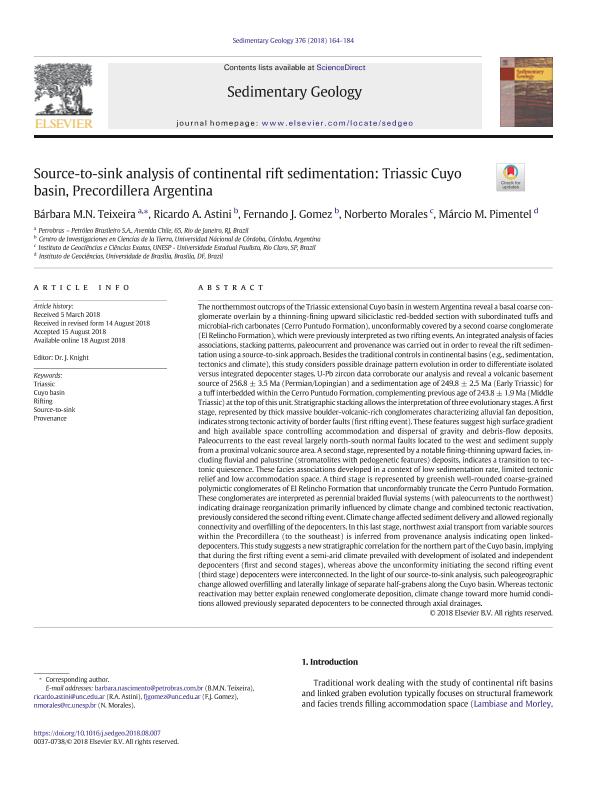Artículo
Source-to-sink analysis of continental rift sedimentation: Triassic Cuyo basin, Precordillera Argentina
Teixeira, Bárbara M. N.; Astini, Ricardo Alfredo ; Gomez, Fernando Javier
; Gomez, Fernando Javier ; Morales, Norberto; Pimentel, Marcio
; Morales, Norberto; Pimentel, Marcio
 ; Gomez, Fernando Javier
; Gomez, Fernando Javier ; Morales, Norberto; Pimentel, Marcio
; Morales, Norberto; Pimentel, Marcio
Fecha de publicación:
11/2018
Editorial:
Elsevier Science
Revista:
Sedimentary Geology
ISSN:
0037-0738
Idioma:
Inglés
Tipo de recurso:
Artículo publicado
Clasificación temática:
Resumen
The northernmost outcrops of the Triassic extensional Cuyo basin in western Argentina reveal a basal coarse conglomerate overlain by a thinning-fining upward siliciclastic red-bedded section with subordinated tuffs and microbial-rich carbonates (Cerro Puntudo Formation), unconformably covered by a second coarse conglomerate (El Relincho Formation), which were previously interpreted as two rifting events. An integrated analysis of facies associations, stacking patterns, paleocurrent and provenance was carried out in order to reveal the rift sedimentation using a source-to-sink approach. Besides the traditional controls in continental basins (e.g., sedimentation, tectonics and climate), this study considers possible drainage pattern evolution in order to differentiate isolated versus integrated depocenter stages. U-Pb zircon data corroborate our analysis and reveal a volcanic basement source of 256.8 ± 3.5 Ma (Permian/Lopingian) and a sedimentation age of 249.8 ± 2.5 Ma (Early Triassic) for a tuff interbedded within the Cerro Puntudo Formation, complementing previous age of 243.8 ± 1.9 Ma (Middle Triassic) at the top of this unit. Stratigraphic stacking allows the interpretation of three evolutionary stages. A first stage, represented by thick massive boulder-volcanic-rich conglomerates characterizing alluvial fan deposition, indicates strong tectonic activity of border faults (first rifting event). These features suggest high surface gradient and high available space controlling accommodation and dispersal of gravity and debris-flow deposits. Paleocurrents to the east reveal largely north-south normal faults located to the west and sediment supply from a proximal volcanic source area. A second stage, represented by a notable fining-thinning upward facies, including fluvial and palustrine (stromatolites with pedogenetic features) deposits, indicates a transition to tectonic quiescence. These facies associations developed in a context of low sedimentation rate, limited tectonic relief and low accommodation space. A third stage is represented by greenish well-rounded coarse-grained polymictic conglomerates of El Relincho Formation that unconformably truncate the Cerro Puntudo Formation. These conglomerates are interpreted as perennial braided fluvial systems (with paleocurrents to the northwest) indicating drainage reorganization primarily influenced by climate change and combined tectonic reactivation, previously considered the second rifting event. Climate change affected sediment delivery and allowed regionally connectivity and overfilling of the depocenters. In this last stage, northwest axial transport from variable sources within the Precordillera (to the southeast) is inferred from provenance analysis indicating open linked-depocenters. This study suggests a new stratigraphic correlation for the northern part of the Cuyo basin, implying that during the first rifting event a semi-arid climate prevailed with development of isolated and independent depocenters (first and second stages), whereas above the unconformity initiating the second rifting event (third stage) depocenters were interconnected. In the light of our source-to-sink analysis, such paleogeographic change allowed overfilling and laterally linkage of separate half-grabens along the Cuyo basin. Whereas tectonic reactivation may better explain renewed conglomerate deposition, climate change toward more humid conditions allowed previously separated depocenters to be connected through axial drainages.
Palabras clave:
CUYO BASIN
,
PROVENANCE
,
RIFTING
,
SOURCE-TO-SINK
,
TRIASSIC
Archivos asociados
Licencia
Identificadores
Colecciones
Articulos(CICTERRA)
Articulos de CENTRO DE INVEST.EN CS.DE LA TIERRA
Articulos de CENTRO DE INVEST.EN CS.DE LA TIERRA
Citación
Teixeira, Bárbara M. N.; Astini, Ricardo Alfredo; Gomez, Fernando Javier; Morales, Norberto; Pimentel, Marcio; Source-to-sink analysis of continental rift sedimentation: Triassic Cuyo basin, Precordillera Argentina; Elsevier Science; Sedimentary Geology; 376; 11-2018; 164-184
Compartir
Altmétricas



